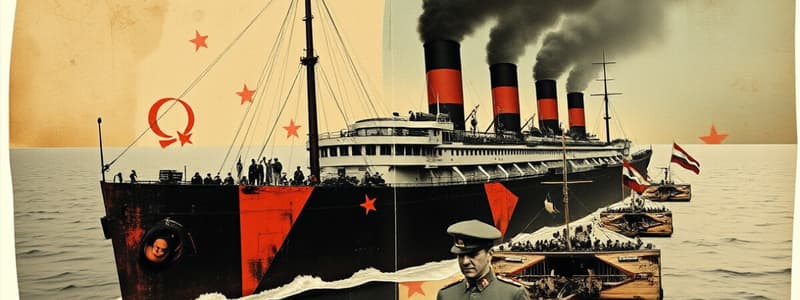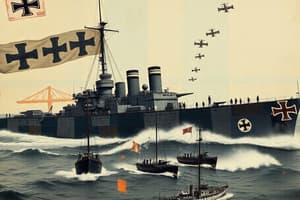Podcast
Questions and Answers
What primary theme does 'Battleship Potemkin' emphasize through its narrative?
What primary theme does 'Battleship Potemkin' emphasize through its narrative?
- The importance of romantic love
- The exploration of human psychology
- The impact of technology on society
- Struggles against oppression (correct)
Which innovative cinematic technique is primarily associated with Eisenstein's direction in 'Battleship Potemkin'?
Which innovative cinematic technique is primarily associated with Eisenstein's direction in 'Battleship Potemkin'?
- Use of synchronized sound
- Single-shot storytelling
- Long takes and slow pacing
- Montage editing (correct)
How did the political climate at the time of its release influence 'Battleship Potemkin'?
How did the political climate at the time of its release influence 'Battleship Potemkin'?
- It prompted the exclusion of national themes.
- It led to a focus on personal stories of romance.
- It encouraged the use of comedic elements in the film.
- It shaped the themes of revolution and class struggle. (correct)
What impact did 'Battleship Potemkin' have on global perceptions of Soviet cinema?
What impact did 'Battleship Potemkin' have on global perceptions of Soviet cinema?
In what way did 'Battleship Potemkin' set a precedent for future filmmakers?
In what way did 'Battleship Potemkin' set a precedent for future filmmakers?
What does the battleship symbolize in the film 'Battleship Potemkin'?
What does the battleship symbolize in the film 'Battleship Potemkin'?
Which aspect of the film emphasizes the importance of collective action?
Which aspect of the film emphasizes the importance of collective action?
What role does martyrdom play in 'Battleship Potemkin'?
What role does martyrdom play in 'Battleship Potemkin'?
Which type of montage did Eisenstein's approach incorporate to enhance storytelling?
Which type of montage did Eisenstein's approach incorporate to enhance storytelling?
What is the primary impact of montage techniques on the audience in 'Battleship Potemkin'?
What is the primary impact of montage techniques on the audience in 'Battleship Potemkin'?
What is significant about the Odessa Steps sequence in the film?
What is significant about the Odessa Steps sequence in the film?
How does 'Battleship Potemkin' illustrate class dynamics?
How does 'Battleship Potemkin' illustrate class dynamics?
Which of the following montage techniques creates tension by using rhythmic editing?
Which of the following montage techniques creates tension by using rhythmic editing?
What does Eisenstein's theory of montage emphasize about the collision of images?
What does Eisenstein's theory of montage emphasize about the collision of images?
Which theme is highlighted through the portrayal of heroic sacrifice in the film?
Which theme is highlighted through the portrayal of heroic sacrifice in the film?
Flashcards are hidden until you start studying
Study Notes
Overview of the Film
- "Battleship Potemkin," directed by Sergei Eisenstein and released in 1925, is a landmark silent film central to cinematic language and propaganda.
- The film narrates the sailors' mutiny on the battleship Potemkin during the 1905 Russian Revolution, emphasizing rebellion, solidarity, and resistance against oppression.
- Eisenstein introduced innovative montage techniques, utilizing rapid editing to elicit emotional responses and convey complex ideas.
Historical Context of the Film's Release
- Released in a politically charged environment post-Bolshevik Revolution (1917), the film reflects themes of revolution and class struggle pertinent to its time.
- The era marked a transformation in cinema as a medium for artistic expression and political messaging, influencing future filmmakers.
- It gained international acclaim, prompting discussions on censorship and artistic freedom that shaped global views of Soviet cinema.
Significance in Film History
- The film significantly influenced filmmakers worldwide, setting a benchmark for narrative and visual storytelling styles.
- Its innovative montage techniques became potent instruments for political propaganda, influencing how films convey ideological messages.
- Frequently analyzed in film studies, it maintains a prominent position as a cornerstone of film history due to its artistic merit and historical significance.
Themes in Battleship Potemkin
-
Revolution and Class Struggle:
- The film encapsulates the 1905 Russian Revolution, portraying the working class's struggle against oppressive regimes and collective action's importance.
- It illustrates class dynamics, highlighting the dire conditions of the proletariat and their quest for justice and equality.
- The battleship symbolizes broader calls for social change and the overthrow of tyranny.
-
The Role of the Collective:
- Emphasizes collective action, showing how the sailors' solidarity enables a successful mutiny against oppressive forces.
- Portrays the transformation of individual sailors into a unified group, underscoring the significance of shared goals and mutual support.
- Comments on social movements, encouraging recognition of strength in unity against oppression.
-
Sacrifice and Martyrdom:
- Depicts heroic sacrifice for the greater good, emphasizing the nobility of the sailors' cause.
- Martyrdom serves as a narrative catalyst, inspiring others to join the struggle and highlighting individual sacrifices' transformative effects.
- Key scenes use sacrifice and martyrdom as symbols of resistance, reinforcing the importance of standing against oppression.
Montage Techniques
-
Definition of Montage:
- A technique involving the editing of various shots to create a cohesive narrative or emotional impact through juxtaposition.
- Eisenstein's approach enhances storytelling by employing visual contrasts and rhythmic editing to emphasize thematic elements.
-
Eisenstein's Theory of Montage:
- Based on the idea that image collisions create new meanings, enabling complex ideas and emotions to be conveyed through visual storytelling.
- Identifies types of montage—metric, rhythmic, tonal, and intellectual—each serving distinct narrative purposes.
-
Examples of Montage in Battleship Potemkin:
- The Odessa Steps sequence exemplifies Eisenstein's mastery, creating a chaotic yet urgent atmosphere to depict a massacre’s brutality.
- Juxtaposition of serene mothers’ faces against violent soldiers evokes strong emotional responses, underscoring the tragedy.
- Rhythmic editing contributes to urgency, guiding audience emotions and reinforcing themes of rebellion and collective struggle.
Iconic Scenes and Their Analysis
-
Odessa Steps Sequence:
- A pivotal scene reflecting brutal repression; rapid cuts depict chaos and emotional turmoil.
- Symbolizes the struggle against oppression, underscoring themes of sacrifice and solidarity.
-
The Mutiny on the Battleship:
- Set against the 1905 Russian Revolution; critical moments include the sailors' revolt against tyrannical officers.
- Illustrates the transformation from individuals to a cohesive group asserting their rights, showcasing collective action's power.
-
The Final Scene and Its Implications:
- Encapsulates rebellion, sacrifice, and collective struggle, leaving a resonating call to action for social change.
- Reflects historical context and its implications for future revolutionary movements.
Reception and Legacy
-
Initial Reception and Controversies:
- Initially praised for its storytelling and innovation, solidifying Eisenstein's status in cinema.
- Faced censorship challenges due to political content, igniting debates about artistic freedom and governmental roles.
-
Influence on Future Filmmakers:
- Introduced groundbreaking techniques, particularly in montage, shaping narrative structures across genres.
- Encouraged exploration of art and politics intersections, using cinema as a medium for social commentary.
-
Battleship Potemkin in Modern Cinema:
- Contemporary filmmakers reference it, showcasing its innovative techniques and storytelling attributes.
- The film's themes influence various genres, remaining culturally relevant in discussions about social movements.
Lasting Impact of Battleship Potemkin
-
Cinematic Revolution:
- Redefined cinema language, introducing innovative techniques that continue to inform filmmakers.
-
Cultural Symbol:
- Represents revolutionary cinema, inspiring discussions on social justice and collective actions globally.
-
Enduring Legacy:
- Themes and techniques resonate in modern filmmaking, making it central in film studies and cultural discourse.
Studying That Suits You
Use AI to generate personalized quizzes and flashcards to suit your learning preferences.





